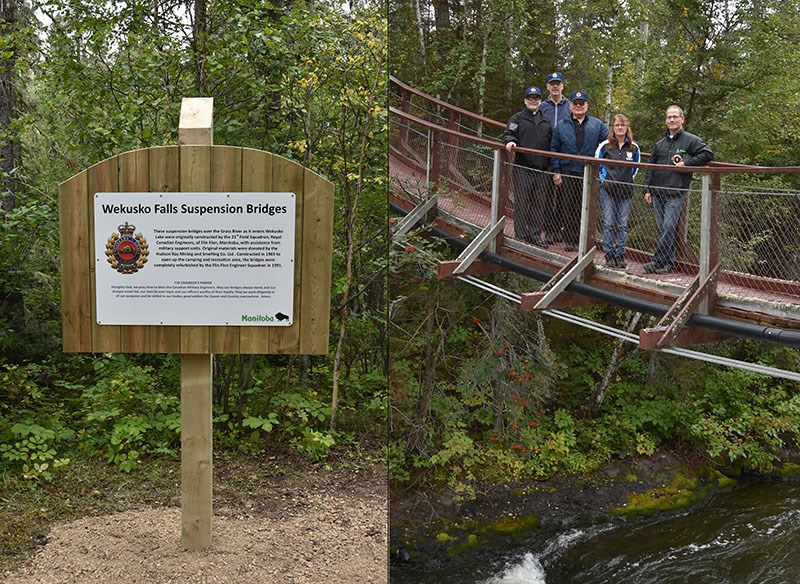It’s been 53 years since the Canadian Engineers 21st Field Squadron set up their transits and focused their efforts on spanning the torrent of water that spills via the Grass River from Tramping Lake into Wekusko. In that time their work has withstood the ravages of time and nature, and the idea drew and impressed a half-century worth of visitors to the spectacle. Two suspension bridges are the legacy of the squadron; they sit 200 metres apart on the river and allow those who traverse them the opportunity to hear the roar and view the majesty of one of Manitoba’s most beautiful landmarks … Wekusko Falls.
On the afternoon of Aug. 31, two of the gentlemen involved in the August 1965 erection of the bridges were back on site to take part in a recognition ceremony. Retired Lt.-Col. Frank Gira
and retired Maj. Morley Naylor are part of the 21 Field Engineer Squadron Historical Committee. They attended Wekusko Falls Provincial Park to place a new sign marking the bridges and honouring those who built them.
With the rumble of the falls in the background and approximately 20 people on hand, Naylor addressed the gathering. Subsequent to acknowledging the work of 21 Field Engineer Squadron and the help and approval of Manitoba Sustainable Development, Naylor introduced Gira. Mr. Gira noted that the installation of the bridges took place 53 years and three day ago. He overviewed the work done and the resources involved. Noting that the signage being unveiled today, courtesy of Manitoba Sustainable Development, would remain a lasting acknowledgement to the members of the squadron, Gira proceeded to review the names of the 44 men who worked on the project.
Mr. Gira then passed things off to Manitoba Sustainable Development district parks supervisor Rodney Forbes. He thanked the men for recognizing the potential of the park and noted the thousands of yearly visitors who are able to enjoy the fruit of their labour. Naylor then gave an explanation of the Field Engineer’s insignia (featured prominently on the new signage), before asking Father Paul Bringleson to speak. Bringleson put forward a fine message based on looking back in order to move forward. He closed with a prayer and the new sign was welcomed with a round of applause. Closing things out, Mr. Gira presented Forbes with a plaque noting the partnership on the project.
The construction of the suspension bridges was conceptualized in the early 1960s and came to fruition in 1965. It was built of anchored steel wire rope (underground hoisting) cables. During construction, the then DNR supplied the carpentry materials and local support, HBM&S the mine hoisting cables and explosives, and the Canadian Army put forward manpower, a mobile kitchen and heavy equipment. An army Boeing CH113A Voyageur helicopter ferried, men, equipment, and support supplies from the staging area at the Flin Flon Armoury.
“The construction phase began by drilling and blasting off the rock faces on each side of the river to allow for proper anchoring of the cables; easy work for miners who were prevalent in the ranks of the engineer squadron,” a Historical Committee handout noted. “The main cables were then strung, anchored, and tensioned, and the wooden transoms emplaced. The meticulous work over the ‘raging torrent’ below proceeded ahead of schedule, allowing members to be spared for a second tasking – that of constructing a second bridge downstream, of local materials. The plan was to install a temporary structure for pedestrians and supplies until the Snow Lake DNR could replace it with an actual suspension bridge. The week-long project saw the participating soldiers challenged in all phases of military engineering including task planning, demolitions, bridge construction, heavy equipment operation as well as carpentry, welding, and hand tool skills.”
Since that time, the Snow Lake DNR office and the 21 Field Engineer Squadron carried out minor repairs and painting in 1979 and major repair work and replacement in 1985. Work completed in 1991 was to be the last for the squadron, as the unit was dissolved in 1995.
In 2008 an engineer assessment was completed on the bridges, noting they would require major modifications to meet standards. Earlier, cables on one of the two suspension bridges had failed and as a result both bridges were closed.
In the summer of 2008 a tender was let and in mid-August of 2009, Millennium Mechanical was hard at it replacing the cables on both bridges. I recall going out to check on their progress during their initial week of work and one of their workers, Dan deMontigny, was jack-hammering holes into the rock, where the new cables would be anchored. He stopped to explain a little about the new system.
deMontigny advised that the bridges would now sit on four cables - two on each side of the bridge. He said that they would be on swivels of sorts and be anchored to the rock with rebar, metal plates, and cement. When asked what the biggest difference was between how the bridges are anchored this time as compared to when Army Engineers did it back in the sixties, deMontigny stated, “Well, we'll be using new cable this time!” The former cables had been used for hoisting by HBM&S then donated when the company replaced them.



